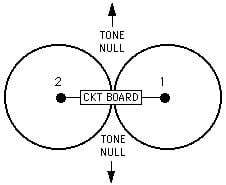The popular RDF (radio direction finder) techniques used by SFARC include:
- A version of the Handi-Finder created by Doug (W2VX) and Greydon (KC6SLE). This device switches between two dipole antennas effectively measuring the TOA
 (time of arrival) that appears as a tone on the HT (handi-talkie). As illustrated on the right the tone will be null (i.e. minimum volume) when the antennas are equidistance from the hidden transmitter thereby providing a vector to/from the hidden transmitter. Once several bearings or vectors have been established and plotted on a map the location of the Fox can be estimated. Mike (K6YMM) presentation on the technique can be found here.
(time of arrival) that appears as a tone on the HT (handi-talkie). As illustrated on the right the tone will be null (i.e. minimum volume) when the antennas are equidistance from the hidden transmitter thereby providing a vector to/from the hidden transmitter. Once several bearings or vectors have been established and plotted on a map the location of the Fox can be estimated. Mike (K6YMM) presentation on the technique can be found here.
 Growing in popularity is the Tape Measure Yagi with a variable attenuator (step attenuator or an offset attenuator). The directional nature of a Yagi enables hunters to point straight at the hidden transmitter. As the the Fox Hunter approaches the Fox, attenuation is required (otherwise the HT will be overloaded and the S-meter will not show a peak).
Growing in popularity is the Tape Measure Yagi with a variable attenuator (step attenuator or an offset attenuator). The directional nature of a Yagi enables hunters to point straight at the hidden transmitter. As the the Fox Hunter approaches the Fox, attenuation is required (otherwise the HT will be overloaded and the S-meter will not show a peak).
- The club continues to explore other RDF technologies. Most recently testing the KrakenSDR which uses five coherent receivers feeding data into a RaspberryPI running the MUSIC (MUtiple SIgnal Classification) algorithm. MUSIC is able to estimate DOA (direction of arrival) and together with a android phone displays a heat map and a vector straight to the hidden transmitter!


